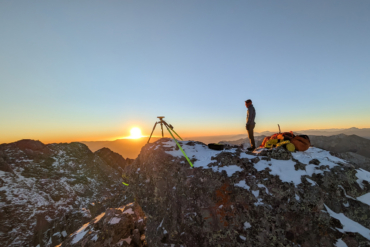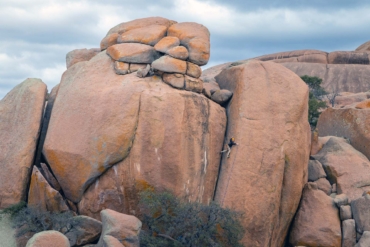If you are new to outdoor sport climbing, you probably want to start with only the essential gear — just enough to go to the sport crag and start climbing safely. You can get all the other interesting and attractive gizmos once you confirm that you are indeed comfortable, interested, and dedicated to advancing in the sport.
Sport Climbing Kit Essentials
Climbing Shoes: Five Ten Kirigami (Men’s and Women’s), La Sportiva Tarantulace (Men’s and Women’s), SCARPA Vapor S (Men’s and Women’s)
As a new outdoor sport climber, you don’t need overly aggressive or tight shoes. The routes appropriate for your outdoor skill level will not require the painful fit of hyper-performance shoes. Comfortable shoes will allow you to focus on proper foot placement and technique instead of worrying about pain in your toes. Or, worse, painful shoes can cause you to avoid fully loading footholds to avoid pressure or pain, a terrible habit.
Comfortable shoes will also allow you to climb longer, and repetition is the key to burning in correct techniques so you can access them without thought later on down the road.
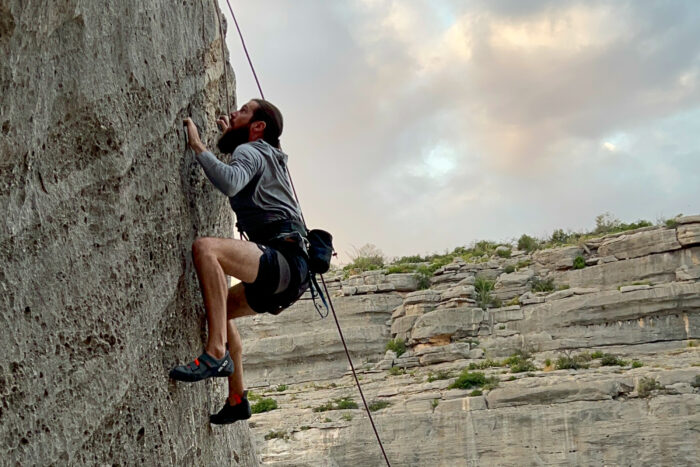
The Five Ten Kirigami is a comfortable climbing shoe that performs well from the gym to trad routes, boulders, and clip-ups. A higher-end group I coach has even used the shoes on long outdoor routes close to their limits when foot comfort was a big factor.
The double-strap Velcro closure made for quick on and off during training sessions, and the textile liner and synthetic upper proved comfortable against the skin even on hot, long, vertical limestone routes in the Pecos River gorge. The legendary adhesion of Stealth C4 rubber was always a confidence booster when the bolts were no longer visible below, all for an MSRP of $100.
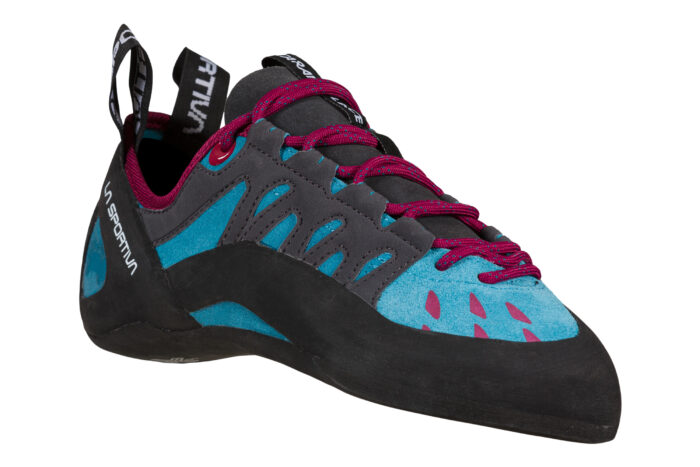
The La Sportiva Tarantulace ($89) has been one of the top-selling climbing shoes on the market for decades. Many new climbers are drawn to the Tarantulace — and for good reason. These shoes don’t specialize in any particular discipline or climbing style, but they are reliable, affordable, and comfortable.
As a long-time employee of climbing gyms, I’ve seen generations of climbers progress from beginner to intermediate level in these shoes. Literally, hundreds of climbers have advanced through the grades to about 5.10+ in these legendary shoes, to my knowledge. The comfort, price, and all-around ability of the Tarantulace are hard to beat for the up-and-coming rock star.
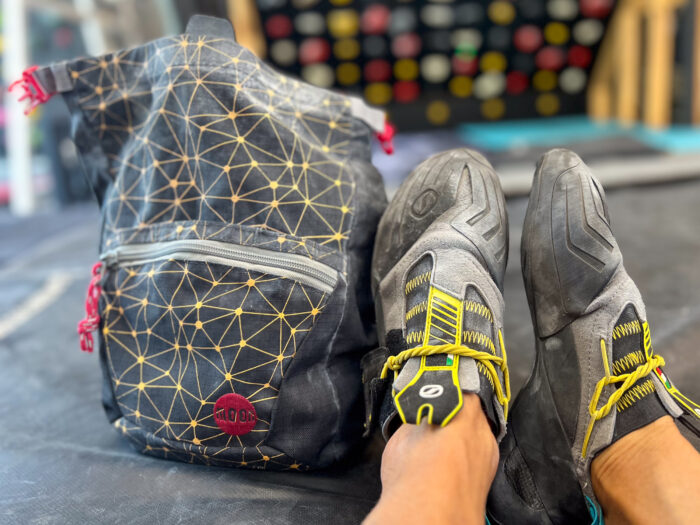
A little further up the ability scale, but still appropriate for those just starting out at the crags, is the SCARPA Vapor S. These slippers had incredible all-day comfort and good performance across all aspects of sport climbing.
And they look to be excellent thin crack shoes. Although the shoe is twice as expensive ($199) as the above choices, it can deliver a new outdoor climber to the higher grades.
The SCARPA Vapor S has moderate downturn and asymmetry, which puts more power on the big toe than most flat beginner shoes. And the fit is slightly more aggressive than the above shoes, adding more precision to that power. A Talyn midsole helped support my foot during long training sessions of hard edging. And the 3.5mm Vibram XS Grip2 rubber held fast to even the sketchiest footholds.
Chalk Bag: Metolius Access Fund
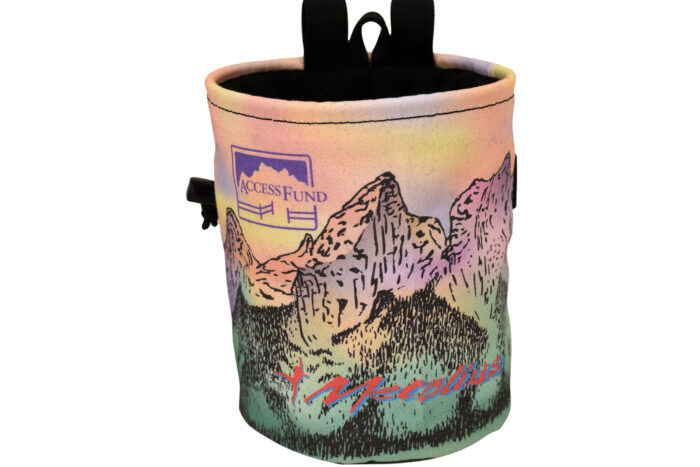
A chalk bag is pretty much a chalk bag. As long as your hand fits in without dragging, closes securely to prevent chalk spillage, and can hold a brush, there isn’t much else to ask of this basic and essential piece of kit.
If you are going to get a new chalk bag, you might as well have the purchase help all climbers. With the Metolius Access Fund bag, a portion of the $25 MSRP goes to the Access Fund to help protect American climbing areas. Metolius offers three different graphics, and I gotta say, they all look amazing for something that is often drab. The Teton version of this chalk bag has gotten more comments on its good looks than any other.
Chalk: Metolius Super Chalk
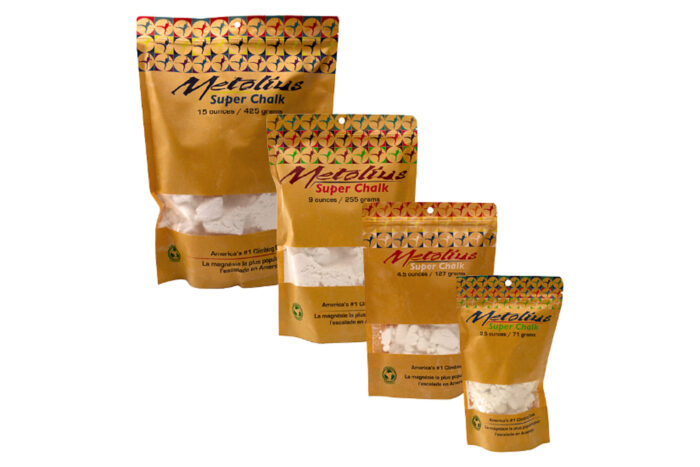
Similar to the chalk bag, chalk is pretty much chalk, but Metolius’ Super Chalk is my favorite. This is after decades of testing every conceivable offering. Some brands add drying agents, fragrances, and other additives to try to concoct a better chalk. But I don’t like to inhale anything potentially harmful.
Metolius simply uses 100% magnesium carbonate and crushes it to the perfect consistency. It’s a blend of powder and chunks that deliver confidence that you are getting the appropriate amount on your paws. And, I like the resealable bag and the low price ($5 for 4.5 ounces).
Climbing Harness: Arc’teryx Konseal (Men’s and Women’s)

Climbing harnesses are the main point of contact with you and the safety system. You will wear the harness 100% of the time you are actively climbing, and you will be experiencing forces through it while you are climbing, belaying, and hangdogging. No other piece of gear in sport climbing, other than shoes, affects your comfort as much. So, a comfortable harness, especially for beginners who may be hanging a lot, is paramount.
A pair of GearJunkie’s most active climbers both wholeheartedly agreed that one of the most comfortable climbing harnesses ever devised is the Arc’teryx Konseal. It may cost a little more ($130) than a harness specifically targeted toward beginners. But we feel that, in this case, a little more upfront cost is worth the increased enjoyment of climbing.
The unique foam padding and adjustable leg loops ensured comfort regardless of how many layers we had on and accommodated variations in body dimensions. And, like other Arc’teryx goods, our testers feel that the Konseal will last a long time. It will also fare well when you advance to multipitch routes.
Belay Device and Belay Carabiner: Edelrid Mega Jul Belay Kit
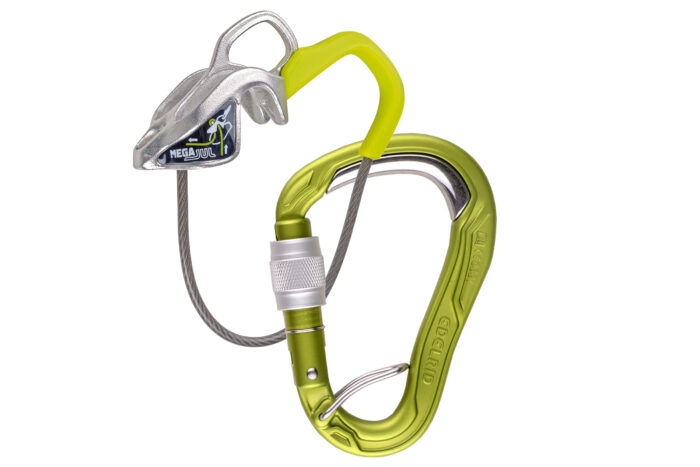
The Edelrid Mega Jul operates just like a tube-style device but offers braking assistance through a passive locking function that requires no additional moving parts. So beginners can learn the proper belay technique while still having that added safety and confidence of braking assistance.
I have been a long-time user of the Mega Jul and a believer in the Edelrid Bulletproof carabiner series, which has a steel insert in the high-wear area where the rope runs. This insert extends the life of the carabiner and rope.
The Edelrid Mega Jul Belay Kit combines the Mega Jul and a HMS Bulletproof screw gate belay carabiner (with a captive belay loop lock) into a package that goes for $73. The Mega Jul is compatible with ropes from 7.9mm to 10.5mm in diameter.
Rope: Edelrid NEO 3R 9.8
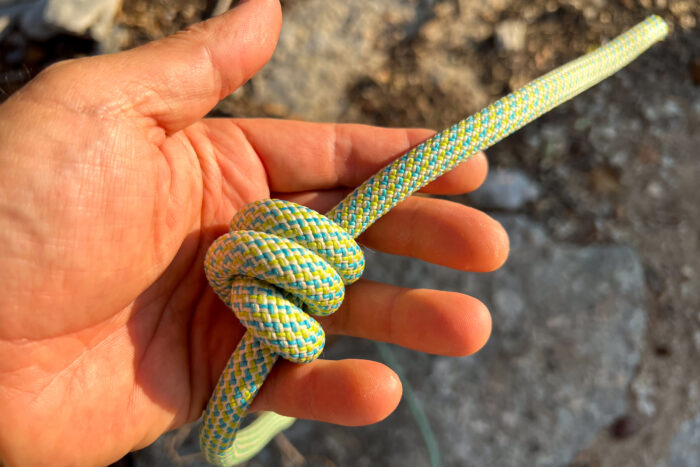
There are so many excellent single dynamic climbing rope choices these days. Most handle and knot well, are durable, have a great hand, and, most importantly, absorb impact forces as designed. Picking between established climbing rope brands can become a chore of splitting incredibly tiny hairs.
But the Edelrid NEO 3R 9.8 stands out. It’s made of 50% fibers that would normally be tossed into the trash bin, making it the first recycled climbing rope. My extensive testing backs up the specifications; this is an excellent climbing rope. This cord is truly a win-win and is my go-to rope for sport climbing.
The 60m version sells for $220, while the 70m version goes for $240.
Rope Bag: Metolius Ropemaster HC

A rope bag is the easiest way to keep your climbing rope organized and clean. I like Metolius’ Ropemaster HC, which took the Best Overall title in our rope bag showdown.
Metolius invented the modern rope bag, debuting its first model in 1991. The Ropemaster HC benefits from decades of experience and updates. The bag is simple, the 52″ x 58″ tarp size is generous, and all the materials, including the aluminum closure buckles, have proven durable in my long-term testing.
The Metolius Ropemaster HC ($50) uses the tried and true fold-and-roll method of stashing the cord. Finally, a clear window allowed quick identification of the rope without unpacking it.
Helmet: Trango Halo
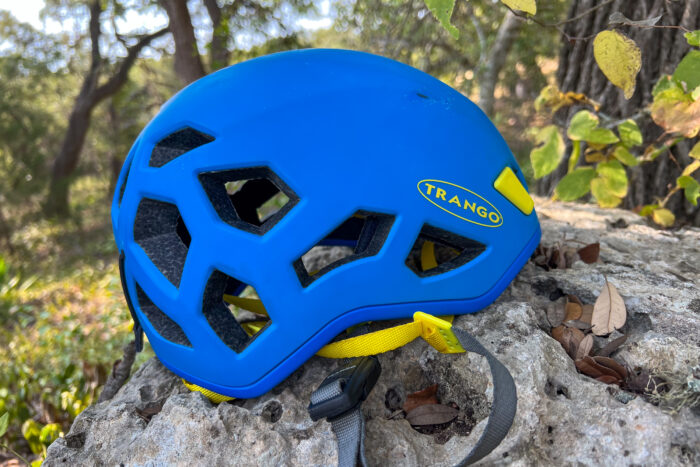
Sport climbing might make it seem like helmets aren’t necessary, but there are countless stories about belayers and bystanders getting hit by falling rocks. Sometimes, the results are devastating and sad, and other times, the story ends with “the helmet saved my life.” Not only does a climbing helmet protect you from falling objects, but it can also protect you during awkward falls, especially while leading.
Although old-school hard plastic brain buckets still exist, especially in institutional settings, but modern climbing helmets are light years ahead. They are so much lighter, more comfortable, more secure, and more ventilated. All these factors make wearing them more probable, and that keeps us all safer.
Some helmets are uber-light, but they can be prone to dings and damage from just transport. The Trango Halo strikes a great balance between low weight and durability while being comfortable and well-ventilated. I’ve been using one as my daily driver for over a year, and despite haphazard treatment, the lid remains undamaged.
And, 100% of the exterior surface has a hard shell covering, protecting the EPS foam from dings. Twenty vents kept me cool even in the brutal Central Texas heat and humidity. Although I was initially frustrated with the magnetic Fidlock closure, once mastered, I admit it was easier than a standard buckle and could be done one-handed if needed.
Quickdraws: Metolius Bravo II Wiregate Quickdraws 5-Pack
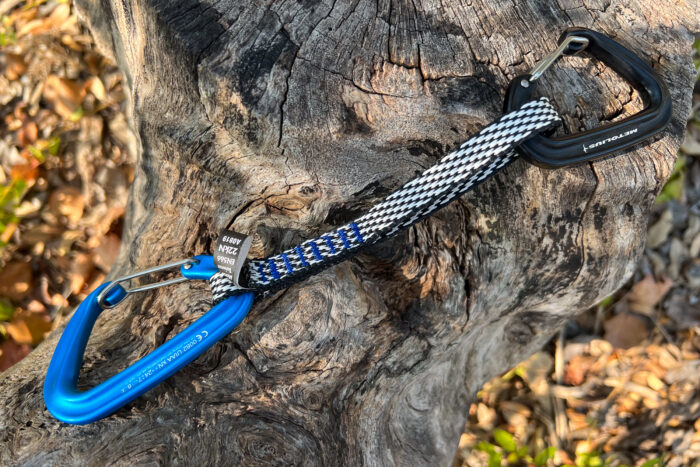
Quickdraws are a combination of two carabiners and one sling that connects them together. These are placed into bolt hangers on the climb and are what catch you and the rope in a fall. Unlike other pieces of your sport climbing kit, you need quite a few quickdraws to get started.
Although there are plenty of ritzy, high-bling factor quickdraws on the market, they can be cost-prohibitive because you need many. The Metolius Bravo II Wiregate Quickdraws 5-pack is a great way to start. Two fully CE/UIAA certified Bravo II wire gate carabiners are connected via a 6-inch-long, 12mm-wide sling that is captive on one side. The wire gate eases rope clipping for those just starting to lead. And the low $99 price helps ensure you can get enough of them.
Two 5-packs should cover you well in most sport climbing areas. Additional quickdraws from your climbing partner will save the day if you’re lucky enough to be in an area with taller routes.
Slings: Black Diamond Equipment 18mm Nylon Runner (120cm)
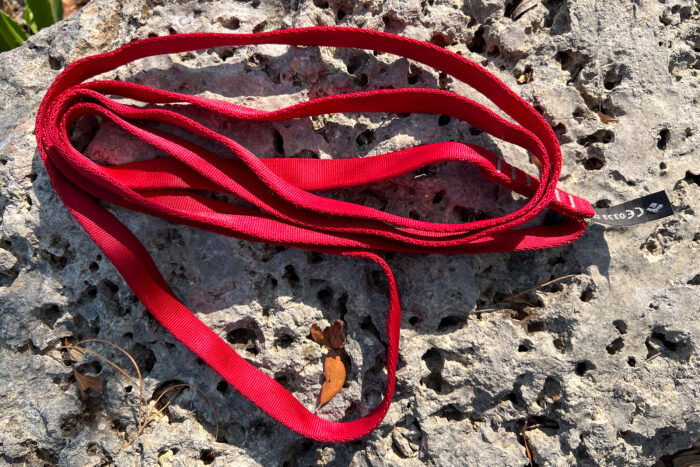
Runners or slings are most often used in conjunction with locking carabiners to connect you to anchors to clean the route. You can also use them to build a top rope anchor. A 120cm sling is most useful, as it can be doubled or knotted if a shorter loop is required.
It’s hard to improve on simple webbing sewn into a loop. They come in nylon and Dyneema versions, but for beginners, I prefer nylon for its higher impact force absorption and lower cost. And the Black Diamond 18mm Nylon Runner has been a staple for eons; if it isn’t broken, don’t fix it.
Locking Carabiners: Petzl Sm’D
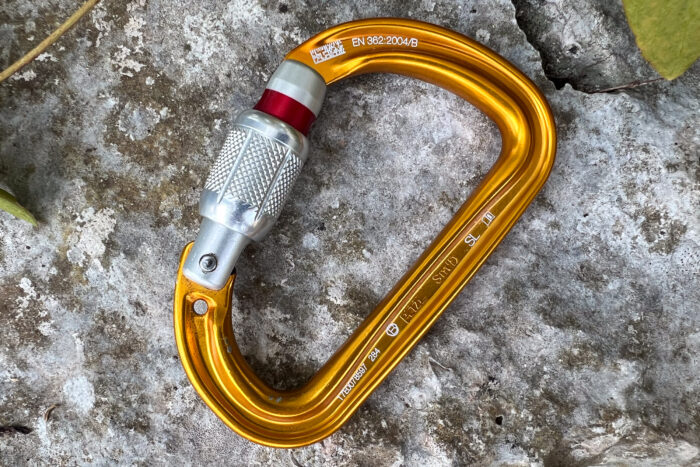
Locking carabiners are used to build any anchor, and it seems like when you need them, there are never enough. A handful of locking carabiners guarantees readiness. The Petzl Sm’D is the right size, the highest quality, and should last you forever. I have hauled Petzl locking carabiners in my packs for decades, and they show no signs of quitting.
At 46 g, the Petzl Sm’D is light, and the key lock gate mechanism resists snagging on other gear. The simple screw lock is foolproof and has a red “no-go” indicator.
The H shape and texture on the screw lock help when your fingers are frozen or sweaty. Finally, a small hole allows tethering ascenders and other devices, making them drop-resistant. You can’t go wrong with these super high-quality locking carabiners.
Crag Pack: Osprey Zealot 45

Although a normal backpack can haul your kit to the crag, crag packs are specifically designed for climbing gear and the potential scrambling that can be a part of the approach. There are many crag packs nowadays, and the more reputable brands have done a fine job of designing these packs for us rock hounds.
The Osprey Zealot 45 impressed one of GearJunkie’s itinerant rock jocks with its excellent mix of capacity, carrying ability, comfort, and price. For sport climbing, it proved to be an ideal partner and looked to be built for the long haul. Osprey throws in a bonus by using recycled ballistic nylon. And, in my eyes, it’s the best-looking crag pack out.
The Osprey Zealot 45 sells for $200.
Interested in learning the ropes of sport climbing but unsure where to start? Check out our article, “Sport Climbing 101: The Best Way to Learn the Ropes.”






